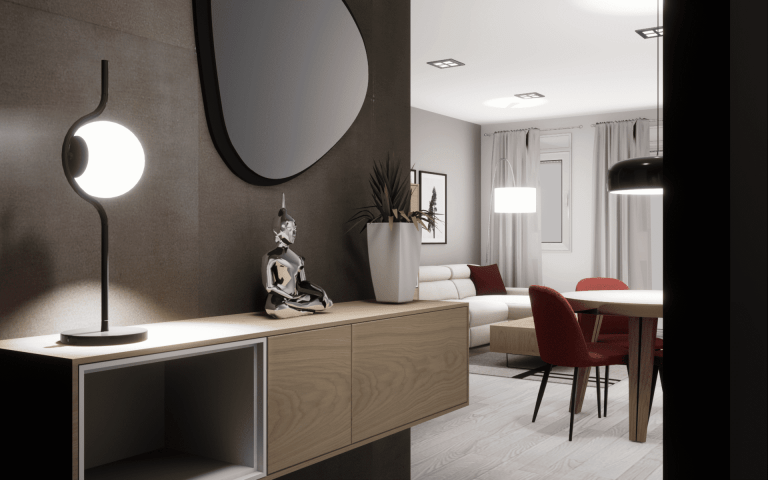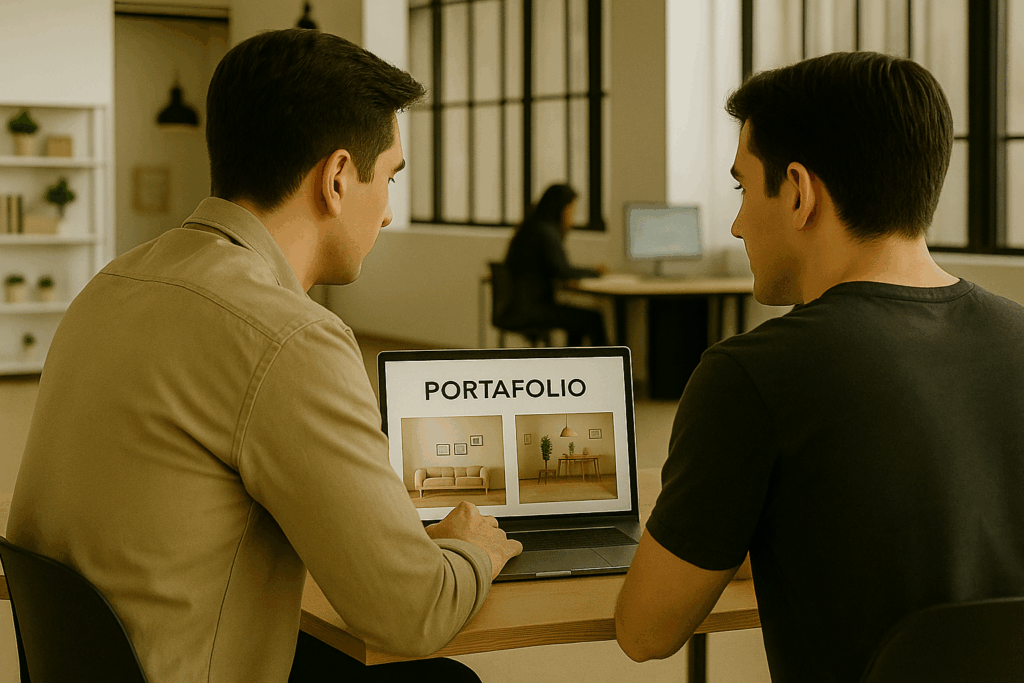In the world of interior design, a strong portfolio is your most powerful introduction.
It’s the tool that communicates your style, your methodology, and your ability to solve real client needs. Whether you’re just starting your career or looking to strengthen your position as a designer, a professional portfolio can open doors, attract collaborations, and build trust with future clients.
In this guide, we walk you through step-by-step how to build a portfolio that represents you and helps you stand out in an increasingly competitive field.
Why is a portfolio so important in interior design?
Because it speaks for you. While your résumé summarizes your experience, the portfolio demonstrates your talent in action. A great portfolio not only showcases completed projects, but also your creative process, your way of thinking about space, and how you turn ideas into livable and aesthetic solutions.
Additionally:
- It reinforces your personal brand: it defines your style, your values, and the types of projects you want to do.
- It builds trust: seeing real, tangible results gives confidence to the client or studio hiring you.
- It serves as a commercial tool: whether to attract clients, apply to studios, or collaborate with brands.

What should a professional interior design portfolio include?
A complete portfolio should reflect both your creative and technical capabilities. These are the essential elements:
1. Introduction or professional bio
Include a short yet personal introduction. Who are you? How did you get into interior design? What inspires you? What kind of projects are you looking for? This section should strike a balance between professional and approachable. Adding a good photo and links to your website or social media boosts credibility.
2. Selection of featured projects
Choose between 5 and 10 relevant projects. You don’t need to include everything you’ve done—just what best represents you.
For each project, include:
Name and type of project (residential, commercial, office…)
Year and location
Objective or initial challenge
Creative process: from concept to final result
Outcomes and applied solutions
Professional photography (before and after, if possible)
Renders, floor plans or moodboards, if you find them relevant
Pro tip: If you don’t have enough real projects yet, include conceptual proposals, collaborations, academic work, or redesigns of existing spaces.
3. Development of your working process
Show how you work—from the first contact, initial sketches or moodboards, use of tools like Teowin Live for 3D renders, to the final presentation. This section adds a lot of value by revealing your professional approach.
4. Consistent visual style
The design of the portfolio itself speaks about you. Use a clean layout or template, with good information hierarchy and a professional font. Every page should reflect good design.
5. Contact information and links
At the end of the portfolio, include all your contact details: email, phone, website, professional social networks (LinkedIn, Behance, Instagram) and, if available, a link to an online version of your portfolio.
Recommended formats for your portfolio
You can create your portfolio in several formats, depending on your objective:
Interactive PDF: ideal for sending by email or showing during interviews.
Printed physical portfolio: perfect for meetings or trade fairs.
Online portfolio: personal website, Behance page or platforms like Issuu, ideal for gaining traffic and visibility.
Extra tip: if you use software like Teowin, you can include screenshots of 3D views, layout simulations or automatically generated budgets to showcase your technical expertise.

Useful tools to create your portfolio
Canva or Adobe InDesign: to design your PDF portfolio professionally.
Behance or Dribbble: platforms to share your work with the creative community.
Teowin Live: to integrate floor plans, renders, moodboards, and custom furniture pieces in your presentation.
Notion or Figma: if you want an editable online portfolio with a great visual experience.
Common mistakes to avoid
Including too many projects: less is more. Choose the best ones and present them well.
Lack of variety or repetition: if all your projects are too similar, you won’t show your versatility.
Poor portfolio design: if the document itself isn’t well designed, it can backfire.
Lack of context: beautiful images are not enough. Explain the reasoning behind your decisions.
Not updating it: keep it current with your latest projects or awards.

What are studios and clients looking for in a portfolio?
Clarity: easy and quick to understand.
Talent: creative and aesthetic ability.
Reasoning: logic behind the design.
Technical skills: use of professional tools and process management.
Personality: what makes you unique.
Our professional opinion
A portfolio is not just a collection of work—it’s a visual representation of who you are as a designer. In such a visual and competitive field as interior design, having a flawless and well-structured portfolio is essential to move forward.
If you also use tools like Teowin, you’re not only showing aesthetic results but also your ability to manage projects comprehensively—from concept to execution.
